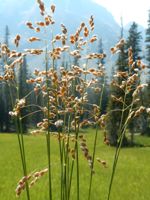Mon-Fri 9am - 5pm Mountain time
Common Gaillardia vs Sweetgrass
Anthoxanthum hirtum/Anthoxanthum nitens (Hierochloe odorata))
Gaillardia aristata
CUSTOM GROW
NOT AVAILABLE THIS SEASON - MIGHT RETURN
Sweetgrass is a cool-season perennial grass best known for its sweet, vanilla-like fragrance. The scent comes from coumarin in the leaves, which is pleasant to humans but has a bitter taste that makes the plant less appealing to deer and other herbivores. As a cool-season grass, Sweetgrass grows most vigorously in spring and fall, slowing or even going dormant during the heat of summer.
It spreads quickly through creeping rhizomes and can be difficult to remove once established, so it is best planted in areas where its spread will not cause problems. Due to its deep, vigorous root system and preference for moist soils, Sweetgrass is especially useful for erosion control, soil stabilization, riparian plantings, and naturalization projects.
Note: Sweetgrass was formerly classified under the scientific name Hierochloe odorata and its subspecies. The subspecies found in Canada are currently considered two distinct species: Anthoxanthum hirtum, which is native across Canada, and Anthoxanthum nitens, which is native to Eastern Canada. Because these two species are alike and share many overlapping common names, they are often considered as only one species.
Common Gaillardia is a native perennial wildflower known for its vibrant, daisy-like blooms. Flower petals vary in color from two-tone blooms with an orange-red center and yellow tips to solid yellow. Blooming from early summer to fall, it provides continuous color while attracting bees, butterflies, and other pollinators. The seeds also serve as a food source for birds, adding to its ecological value.
Common Gaillardia is easy to grow and can tolerate heat and drought. If flowering slows in the summer heat, cutting back the plant can encourage a new round of blooms in the fall. It is ideal for pollinator gardens, xeriscaping, naturalization projects, and ornamental plantings.
Sweetgrass Quick Facts
Common Gaillardia Quick Facts
Toxicity: toxic if large amounts ingested

